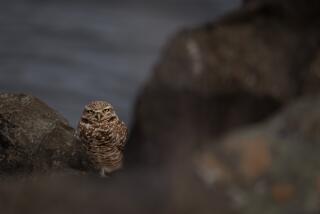On a Wing and a Prayer : Effort to Lure Swallows Back to Mission Short on Funds but High on Hope
- Share via
SAN JUAN CAPISTRANO — A clever scheme to lure the legendary swallows back to their historic home at Mission San Juan Capistrano is being scaled down because a fund-raising effort has barely gotten off the ground.
The private tourism group behind the effort to install 500 replica nests at the 219-year-old edifice, replacing the natural nests destroyed during work to make the mission earthquake-safe, has been torn by personality squabbles and unable to raise enough money.
“We don’t have the money right now for 500,” said Gerald Miller, the mission’s administrator. “It’s a disappointment. It’s put a hole in our plans.”
Instead, mission officials hope by mid-May to install only 100 of the clay nests that are handcrafted by a Norco artist who was enlisted for a program developed earlier this year to entice the world-famous swallows that have been abandoning the mission in increasing numbers.
The program also involves releasing thousands of insects on the mission grounds each week to give the birds plentiful dining and providing an ample source of fresh mud for any birds wishing to build their own affordable housing.
San Juan Capistrano’s image is largely wrapped in the folklore of the swallows, tiny darting birds whose nests are protected by a city ordinance.
According to legend, the birds have been coming back to the mission for more than 200 years. Father Junipero Serra is said to have welcomed the birds that were chased off by a nearby innkeeper who hated the mess they made.
Tourists pack the city every March 19 in anticipation of seeing the birds’ annual return, even though the number of birds has dwindled as their habitat has been ruined. This year, nearly 17,000 people visited the mission on Swallows Day.
But the plan to bring back the swallows has suffered a setback.
Disagreements among members of the San Juan Capistrano Hospitality Council, a group of local restaurant owners and business people formed in February to help raise money for the nesting program, caused some members to quit.
The group, which has raised only $300, has been dormant in recent weeks because of what members describe as personality clashes.
Tim Bolen, publisher of the Swallows Tale and a founding member of the hospitality council, said the group intends to make a comeback with a revised set of members.
However, Bolen said the group doesn’t have the ability alone to raise the more than $8,000 needed for the nesting project.
“All we can do is put out an appeal to various agencies to help us solve this problem” of bringing the swallows back, Bolen said. “It’s not a problem we can solve overnight. It’s something that will take a couple of years.”
Sigismund Hau, the owner of Cafe Mozart and a hospitality council member who quit, said he and other restaurateurs have banded together in their own group to continue raising funds for the mission.
“We need to unify business, the Chamber of Commerce and the mission to follow up on the nesting program,” Hau said.
The intense effort to lure the swallows drew national media attention in the days and weeks leading up to the city’s annual celebration to welcome the birds back from Argentina.
Only about a dozen natural nests remain at the swallows’ seasonal home. The earthquake retrofitting begun six years ago at the mission caused the birds’ numbers to plummet.
So far, only nine of the replica clay nests have been installed, but wildlife experts say it’ll take time before many birds start coming back to the mission.
Linda McLeod Evans, executive director of the Laguna Niguel-based Pacific Wildlife Project, said putting up the clay nests and releasing bugs won’t automatically attract thousands of swallows.
She said it would be a success if even four new pairs of nesting swallows take up residence by the end of summer.
“This plan could work, but we really need (financial) help,” Evans said.
Lyrae Perry, the artist who is making the nests at $17 each, is confident that the program will be completed, even if it takes longer than had been expected.
“It’s a long-term project,” Perry said. “Most of the biologists we spoke with agree it will take about two to three years to get the birds back to the numbers they used to be.”
The cash-strapped mission has spent $3,000 for the project but was hoping to recoup that money and raise the rest necessary to install the 500 nests, Miller said.
“We’re anxious to get going,” he said.
(BEGIN TEXT OF INFOBOX / INFOGRAPHIC)
Bird Housing Wildlife artist Lyrae Perry handcrafted nine swallows nests of nontoxic clay to replace natural nests destroyed at the San Juan Capistrano Mission during earthquake-proofing work. How she did it: Mouth: 1 1/2 inches across Wall: Less than 1/4 inch thick Height: 6-8 inches Width: 6-8 inches
The Tenants One pair of swallows at a time can use an artist-made or natural nest to hatch their young. Some facts about nesting swallows: * Incubation: 14 days * Brood: One per season, 3-4 babies * Breeding season: April-August * Life span: Typically 3-4 breeding seasons; as long as 10 years * Fidelity: Monogamous, with both parents sharing nest-building and feeding of young * Nest furnishings: Sometimes a layer of dried grass * Lease: Parents and young vacate nest after four weeks, new breeding pair moves in * Natural nests: Two birds make 1,400 mouthful-size trips to transport 900-1,200 mud pellets Source: Pacific Wildlife Project
More to Read
Sign up for Essential California
The most important California stories and recommendations in your inbox every morning.
You may occasionally receive promotional content from the Los Angeles Times.













